engine overheat MAZDA MODEL 6 2020 Owner's Manual (in English)
[x] Cancel search | Manufacturer: MAZDA, Model Year: 2020, Model line: MODEL 6, Model: MAZDA MODEL 6 2020Pages: 702
Page 132 of 702
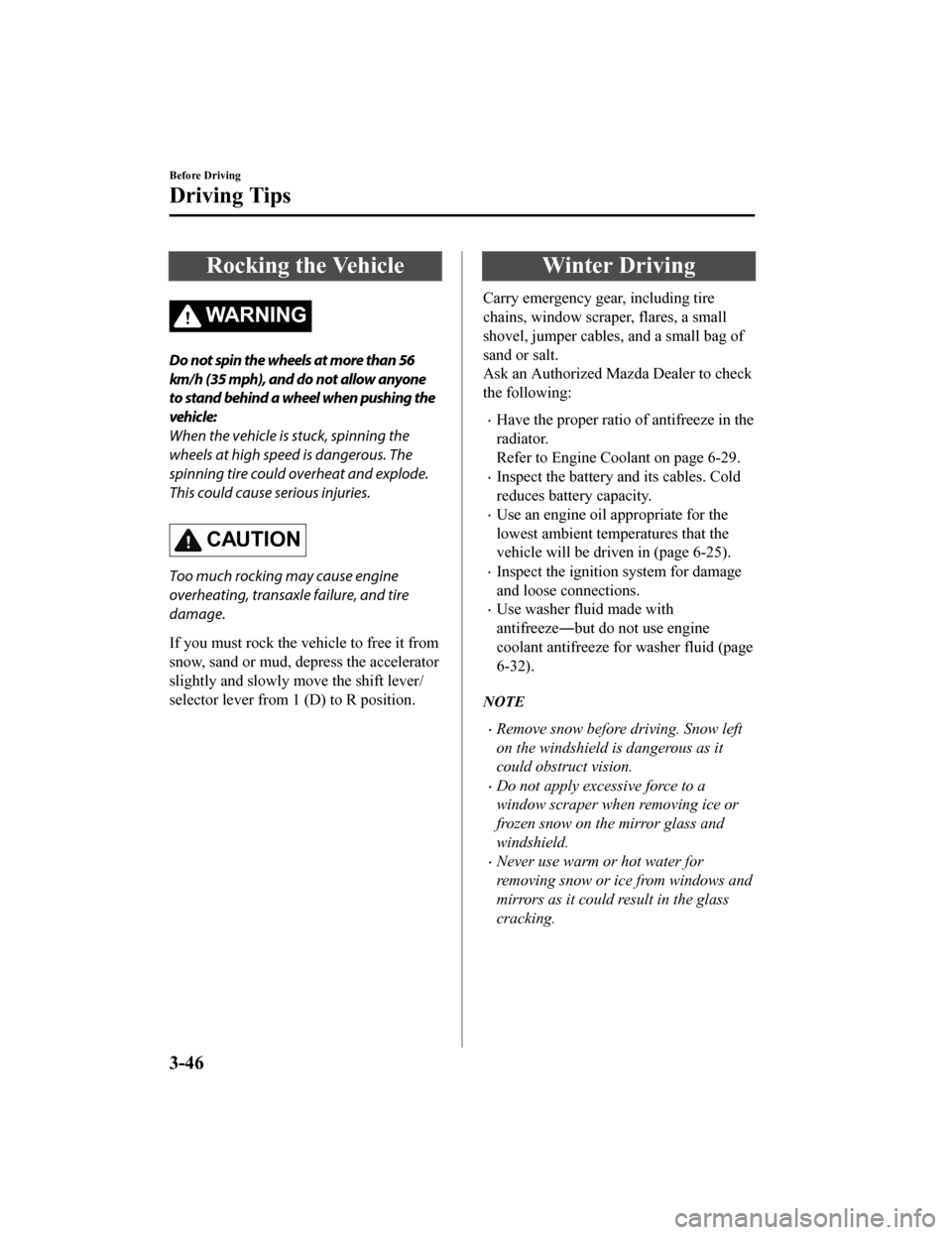
Rocking the Vehicle
WA R N I N G
Do not spin the wheels at more than 56
km/h (35 mph), and do not allow anyone
to stand behind a wheel when pushing the
vehicle:
When the vehicle is stuck, spinning the
wheels at high speed is dangerous. The
spinning tire could overheat and explode.
This could cause serious injuries.
CAUTION
Too much rocking may cause engine
overheating, transaxle failure, and tire
damage.
If you must rock the vehicle to free it from
snow, sand or mud, depress the accelerator
slightly and slowly move the shift lever/
selector lever from 1 (D) to R position.
Winter Driving
Carry emergency gear, including tire
chains, window scraper, flares, a small
shovel, jumper cables, and a small bag of
sand or salt.
Ask an Authorized Mazda Dealer to check
the following:
Have the proper ratio of antifreeze in the
radiator.
Refer to Engine Coolant on page 6-29.
Inspect the battery and its cables. Cold
reduces battery capacity.
Use an engine oil appropriate for the
lowest ambient temperatures that the
vehicle will be driven in (page 6-25).
Inspect the ignition system for damage
and loose connections.
Use washer fluid made with
antifreeze―but do not use engine
coolant antifreeze for washer fluid (page
6-32).
NOTE
Remove snow before driving. Snow left
on the windshield is dangerous as it
could obstruct vision.
Do not apply excessive force to a
window scraper when removing ice or
frozen snow on the mirror glass and
windshield.
Never use warm or hot water for
removing snow or ice from windows and
mirrors as it could result in the glass
cracking.
Before Driving
Driving Tips
3-46
Mazda6_8HX3-EA-19I_Edition1_old 2019-6-18 9:25:17
Page 157 of 702
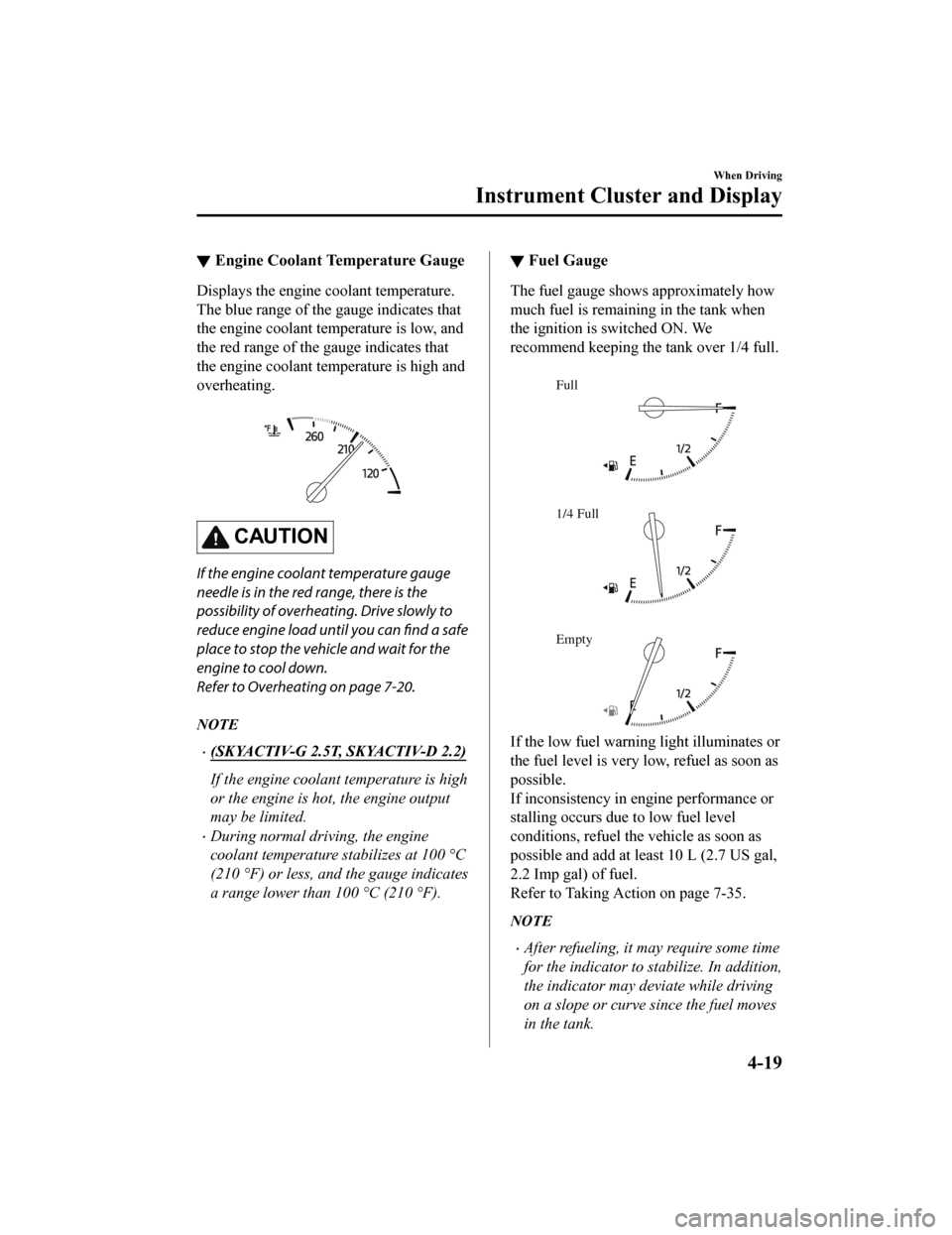
▼Engine Coolant Temperature Gauge
Displays the engine coolant temperature.
The blue range of the gauge indicates that
the engine coolant temperature is low, and
the red range of the gauge indicates that
the engine coolant temperature is high and
overheating.
CAUTION
If the engine coolant temperature gauge
needle is in the red range, there is the
possibility of overheating. Drive slowly to
reduce engine load until you can find a safe
place to stop the vehicle and wait for the
engine to cool down.
Refer to Overheating on page 7-20.
NOTE
(SKYACTIV-G 2.5T, SKYACTIV-D 2.2)
If the engine coolant temperature is high
or the engine is hot, the engine output
may be limited.
During normal driving, the engine
coolant temperature stabilizes at 100 °C
(210 °F) or less, and the gauge indicates
a range lower than 100 °C (210 °F).
▼Fuel Gauge
The fuel gauge shows approximately how
much fuel is remaining in the tank when
the ignition is switched ON. We
recommend keeping the tank over 1/4 full.
Full
1/4 Full
Empty
If the low fuel warni
ng light illuminates or
the fuel level is very low, refuel as soon as
possible.
If inconsistency in engine performance or
stalling occurs due to low fuel level
conditions, refuel the vehicle as soon as
possible and add at least 10 L (2.7 US gal,
2.2 Imp gal) of fuel.
Refer to Taking Action on page 7-35.
NOTE
After refueling, it may require some time
for the indicator to stabilize. In addition,
the indicator may deviate while driving
on a slope or curve since the fuel moves
in the tank.
When Driving
Instrument Cluster and Display
4-19
Mazda6_8HX3-EA-19I_Edition1_old 2019-6-18 9:25:17
Page 174 of 702
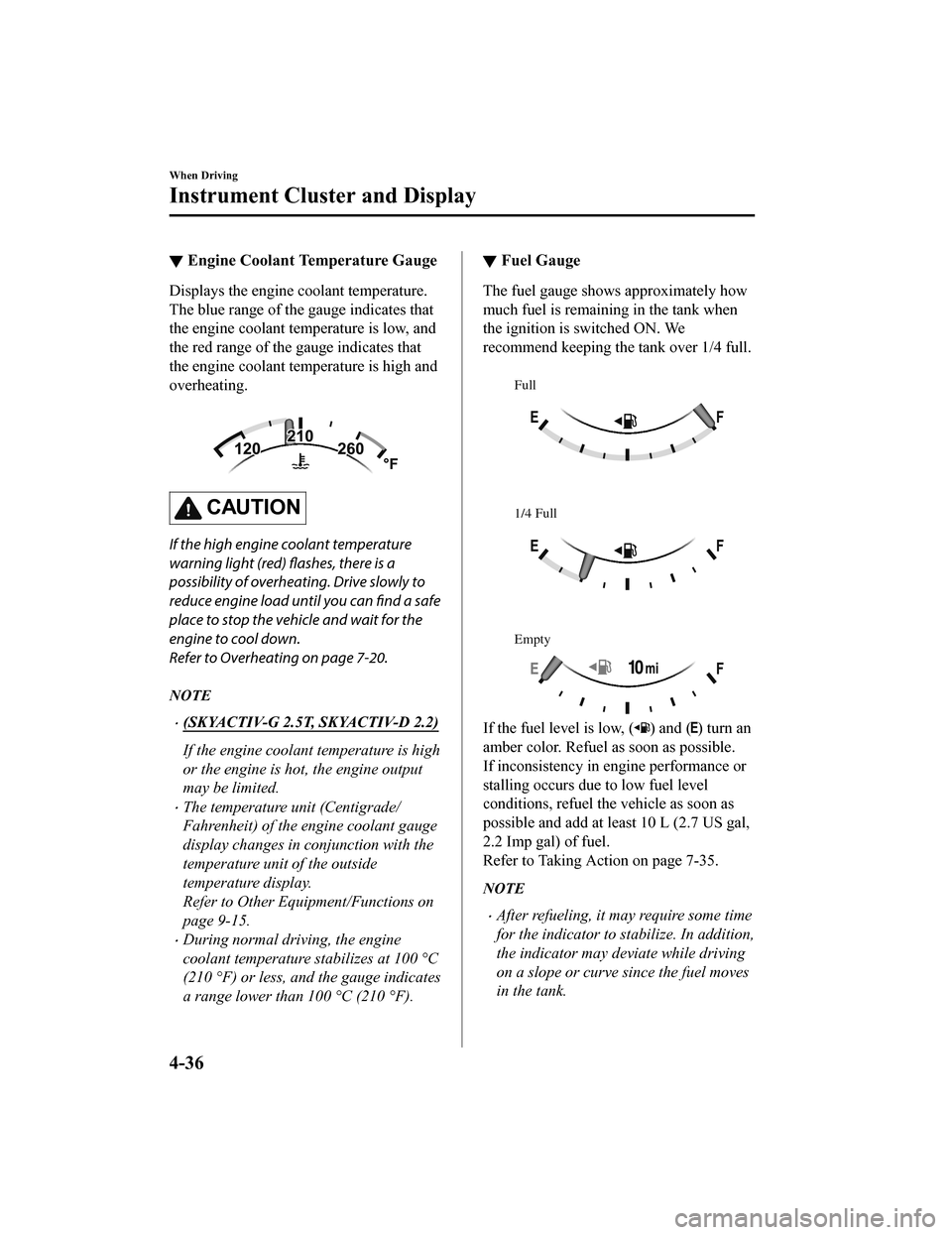
▼Engine Coolant Temperature Gauge
Displays the engine coolant temperature.
The blue range of the gauge indicates that
the engine coolant temperature is low, and
the red range of the
gauge indicates that
the engine coolant temperature is high and
overheating.
CAUTION
If the high engine coolant temperature
warning light (red) flashes, there is a
possibility of overheating. Drive slowly to
reduce engine load until you can find a safe
place to stop the vehicle and wait for the
engine to cool down.
Refer to Overheating on page 7-20.
NOTE
(SKYACTIV-G 2.5T, SKYACTIV-D 2.2)
If the engine coolant temperature is high
or the engine is hot, the engine output
may be limited.
The temperature unit (Centigrade/
Fahrenheit) of the engine coolant gauge
display changes in conjunction with the
temperature unit of the outside
temperature display.
Refer to Other Equipment/Functions on
page 9-15.
During normal driving, the engine
coolant temperature stabilizes at 100 °C
(210 °F) or less, and the gauge indicates
a range lower than 100 °C (210 °F).
▼ Fuel Gauge
The fuel gauge shows approximately how
much fuel is remaining in the tank when
the ignition is switched ON. We
recommend keeping the tank over 1/4 full.
Full
1/4 Full
Empty
If the fuel level is low, () and () turn an
amber color. Refuel as soon as possible.
If inconsistency in e ngine performance or
stalling occurs due to low fuel level
conditions, refuel the vehicle as soon as
possible and add at least 10 L (2.7 US gal,
2.2 Imp gal) of fuel.
Refer to Taking Action on page 7-35.
NOTE
After refueling, it may require some time
for the indicator to st abilize. In addition,
the indicator may deviate while driving
on a slope or curve since the fuel moves
in the tank.
When Driving
Instrument Cluster and Display
4-36
Mazda6_8HX3-EA-19I_Edition1_old 2019-6-18 9:25:17
Page 191 of 702

▼Engine Coolant Temperature Gauge
Displays the engine coolant temperature.
The white range of the gauge indicates
that the engine coolant temperature is low,
and the red range of the gauge indicates
that the engine coolant temperature is high
and overheating.
CAUTION
If the engine coolant temperature gauge
needle (white) flashes, there is a possibility
of overheating. Drive slowly to reduce
engine load until you can
find a safe place
to stop the vehicle and wait for the engine
to cool down.
Refer to Overheating on page 7-20.
NOTE
(SKYACTIV-G 2.5T)
If the engine coolant temperature is high
or the engine is hot, the engine output
may be limited.
The temperature unit (Centigrade/
Fahrenheit) of the engine coolant gauge
display changes in conjunction with the
temperature unit of the outside
temperature display.
Refer to Other Equipment/Functions on
page 9-15.
During normal driving, the engine
coolant temperature stabilizes at 100 °C
(210 °F) or less, and the gauge indicates
a range lower than 100 °C (210 °F).
▼ Fuel Gauge
The fuel gauge shows approximately how
much fuel is remaining in the tank when
the ignition is switched ON. We
recommend keeping the tank over 1/4 full.
Full
1/4 Full
Empty
If the low fuel warni
ng light illuminates or
the fuel level is very low, refuel as soon as
possible.
If inconsistency in engine performance or
stalling occurs due to low fuel level
conditions, refuel the vehicle as soon as
possible and add at least 10 L (2.7 US gal,
2.2 Imp gal) of fuel.
Refer to Taking Action on page 7-35.
NOTE
After refueling, it may require some time
for the indicator to stabilize. In addition,
the indicator may deviate while driving
on a slope or curve since the fuel moves
in the tank.
When Driving
Instrument Cluster and Display
4-53
Mazda6_8HX3-EA-19I_Edition1_old 2019-6-18 9:25:17
Page 236 of 702
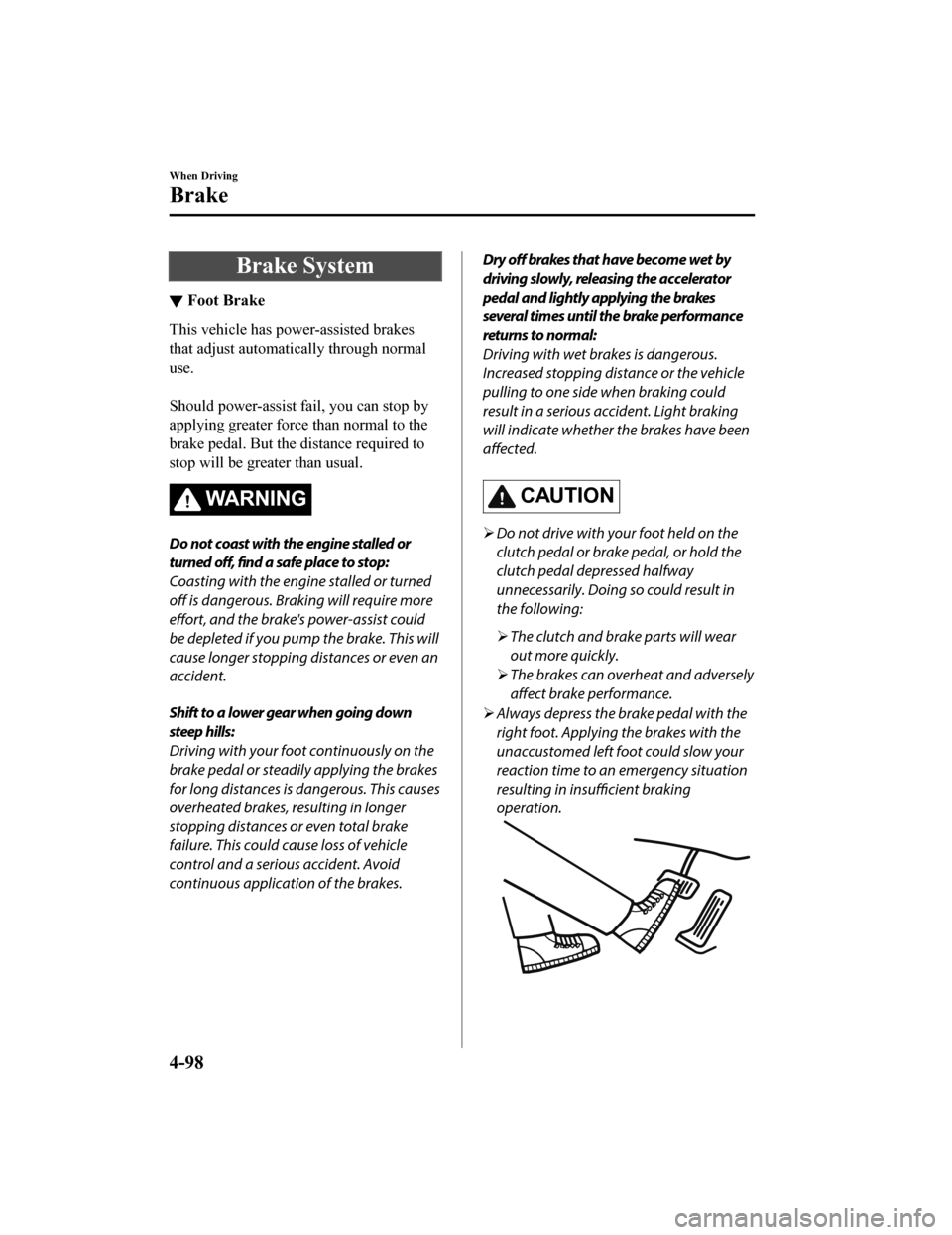
Brake System
▼Foot Brake
This vehicle has power-assisted brakes
that adjust automatically through normal
use.
Should power-assist fail, you can stop by
applying greater force than normal to the
brake pedal. But the d
istance required to
stop will be greater than usual.
WA R N I N G
Do not coast with the engine stalled or
turned off,
find a safe place to stop:
Coasting with the engine stalled or turned
off is dangerous. Braking will require more
effort, and the brake's power-assist could
be depleted if you pump the brake. This will
cause longer stopping distances or even an
accident.
Shift to a lower gear when going down
steep hills:
Driving with your foot continuously on the
brake pedal or steadily applying the brakes
for long distances is dangerous. This causes
overheated brakes, resulting in longer
stopping distances or even total brake
failure. This could cause loss of vehicle
control and a serious accident. Avoid
continuous application of the brakes.
Dry off brakes that have become wet by
driving slowly, releasing the accelerator
pedal and lightly applying the brakes
several times until the brake performance
returns to normal:
Driving with wet brakes is dangerous.
Increased stopping distance or the vehicle
pulling to one side when braking could
result in a serious accident. Light braking
will indicate whether the brakes have been
affected.
CAUTION
Do not drive with your foot held on the
clutch pedal or brake pedal, or hold the
clutch pedal depressed halfway
unnecessarily. Doing so could result in
the following:
The clutch and brake parts will wear
out more quickly.
The brakes can overheat and adversely
affect brake performance.
Always depress the brake pedal with the
right foot. Applying the brakes with the
unaccustomed left foot could slow your
reaction time to an emergency situation
resulting in insufficient braking
operation.
When Driving
Brake
4-98
Mazda6_8HX3-EA-19I_Edition1_old 2019-6-18 9:25:17
Page 557 of 702
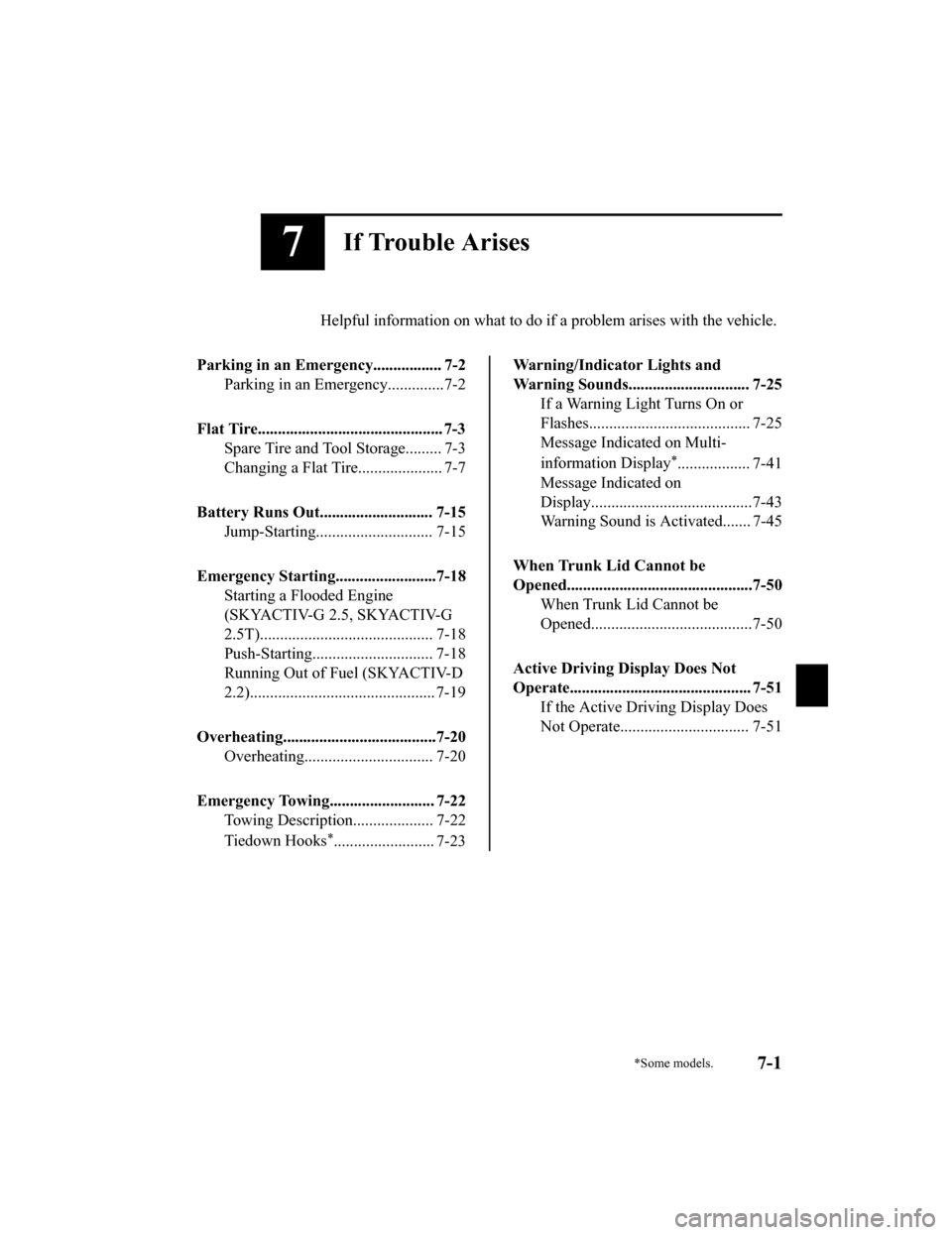
7If Trouble Arises
Helpful information on what to do if a problem arises with the vehicle.
Parking in an Emergency................. 7-2 Parking in an Emergency..............7-2
Flat Tire.............................................. 7-3 Spare Tire and Tool Storage......... 7-3
Changing a Flat Tire..................... 7-7
Battery Runs Out............................ 7-15 Jump-Starting............................. 7-15
Emergency Starting.........................7-18 Starting a Flooded Engine
(SKYACTIV-G 2.5, SKYACTIV-G
2.5T)........................................... 7-18
Push-Starting.............................. 7-18
Running Out of Fuel (SKYACTIV-D
2.2).............................................. 7-19
Overheating......................................7-20 Overheating................................ 7-20
Emergency Towing.......................... 7-22 Towing Description.................... 7-22
Tiedown Hooks
*......................... 7-23
Warning/Indicator Lights and
Warning Sounds.............................. 7-25If a Warning Light Turns On or
Flashes........................................ 7-25
Message Indicated on Multi-
information Display
*.................. 7-41
Message Indicated on
Display........................................7-43
Warning Sound is Activated....... 7-45
When Trunk Lid Cannot be
Opened..............................................7-50 When Trunk Lid Cannot be
Opened........................................7-50
Active Driving Display Does Not
Operate............................................. 7-51 If the Active Driving Display Does
Not Operate................................ 7-51
*Some models.7-1
Mazda6_8HX3-EA-19I_Edition1_old 2019-6-18 9:25:17
Page 576 of 702
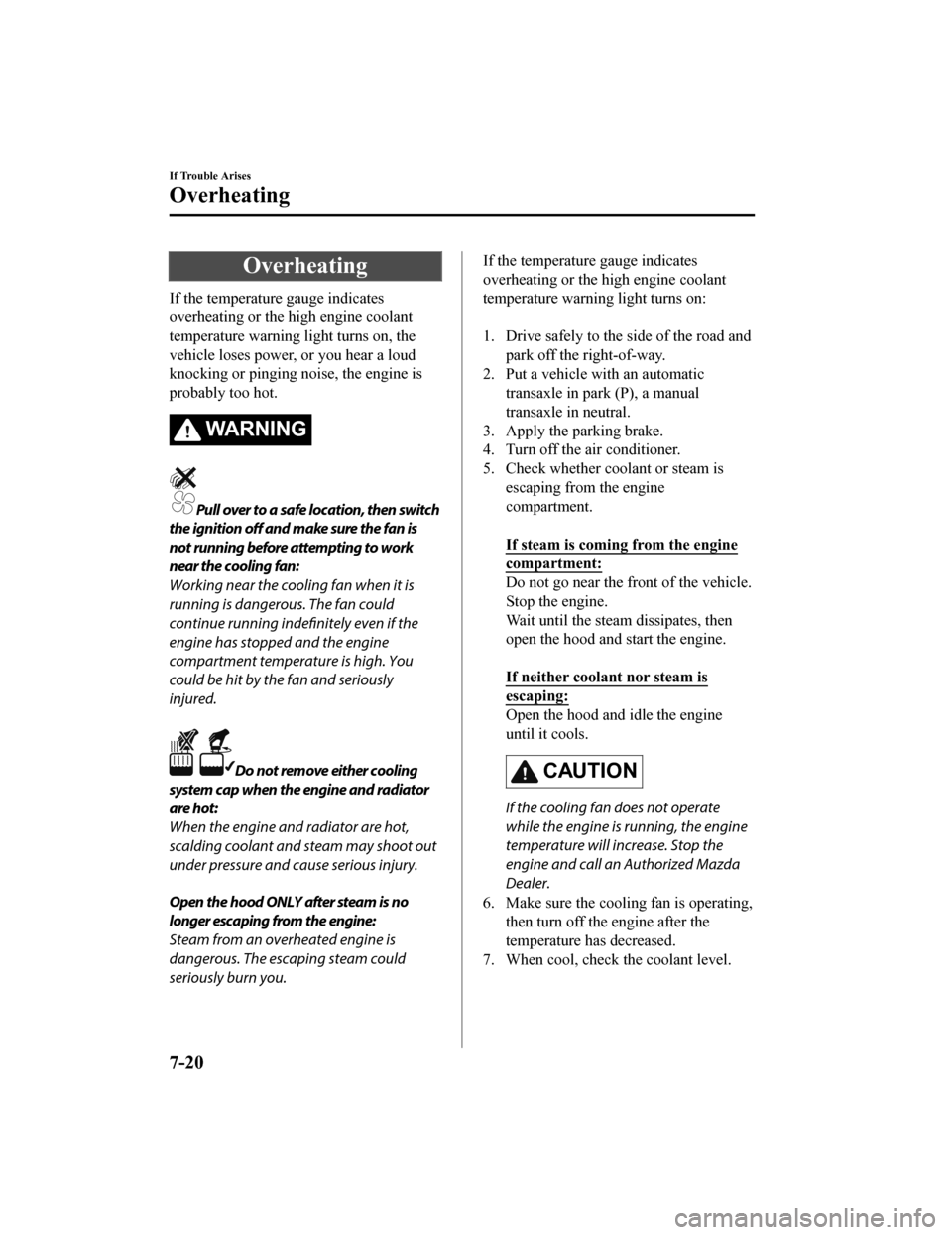
Overheating
If the temperature gauge indicates
overheating or the high engine coolant
temperature warning light turns on, the
vehicle loses power, or you hear a loud
knocking or pinging noise, the engine is
probably too hot.
WA R N I N G
Pull over to a safe location, then switch
the ignition off and make sure the fan is
not running before attempting to work
near the cooling fan:
Working near the cooling fan when it is
running is dangerous. The fan could
continue running indefinitely even if the
engine has stopped and the engine
compartment temperature is high. You
could be hit by the fan and seriously
injured.
Do not remove either cooling
system cap when the engine and radiator
are hot:
When the engine and radiator are hot,
scalding coolant and steam may shoot out
under pressure and cause serious injury.
Open the hood ONLY after steam is no
longer escaping from the engine:
Steam from an overheated engine is
dangerous. The escaping steam could
seriously burn you.
If the temperature gauge indicates
overheating or the high engine coolant
temperature warning light turns on:
1. Drive safely to the side of the road and
park off the right-of-way.
2. Put a vehicle with an automatic transaxle in park (P), a manual
transaxle in neutral.
3. Apply the parking brake.
4. Turn off the air conditioner.
5. Check whether coolant or steam is escaping from the engine
compartment.
If steam is coming from the engine
compartment:
Do not go near the front of the vehicle.
Stop the engine.
Wait until the steam dissipates, then
open the hood and start the engine.
If neither coolant nor steam is
escaping:
Open the hood and idle the engine
until it cools.
CAUTION
If the cooling fan does not operate
while the engine is running, the engine
temperature will increase. Stop the
engine and call an Authorized Mazda
Dealer.
6. Make sure the cooling fan is operating, then turn off the engine after the
temperature has decreased.
7. When cool, check the coolant level.
If Trouble Arises
Overheating
7-20
Mazda6_8HX3-EA-19I_Edition1_old 2019-6-18 9:25:17
Page 577 of 702

If it is low, look for coolant leaks from
the radiator and hoses.
If you find a leak or other damage, or if
coolant is still leaking:
Stop the engine and call an Authorized
Mazda Dealer.
SKYACTIV-G 2.5
Cooling system cap
Coolant
reservoir
Cooling fan
SKYACTIV-G 2.5T
Cooling system cap
Coolant reservoir
Cooling fan
SKYACTIV-D 2.2
Coolant reservoir
Cooling fanCooling system cap
If you find no problems, the engine is
cool, and no leaks are obvious:
Carefully add coolant as required (page
6-29).
CAUTION
If the engine continues to overheat or
frequently overheats, have the cooling
system inspected. The engine could be
seriously damaged unless repairs are
made. Consult an Authorized Mazda
Dealer.
If Trouble Arises
Overheating
7-21
Mazda6_8HX3-EA-19I_Edition1_old 2019-6-18 9:25:17
Page 583 of 702

SignalWarning
Charging System Warn‐
ing Indication/Warning Light If the warning light illuminates
while driving, it indicates a malfunction of the alter‐
nator or of the charging system.
Drive to the side of the road and park off the right-of-way. Co nsult an Authorized
Mazda Dealer.
CAUTION
Do not continue driving when the charging system warning light is illuminated be‐
cause the engine could stop unexpectedly.
Engine Oil Warning Light This warning light indicates
low engine oil pressure.
CAUTION
Do not run the engine if the oil pressure is low. Otherwise, it could result in extensive
engine damage.
If the light illuminates or the warning indication is displayed while driving:
1. Drive to the side of the road and park off the right-of-way o n level ground.
2. Turn off the engine and wait 5 minutes for the oil to drain back into the oil pan.
3. Inspect the engine oil level (page 6-28). If it's low, add th e appropriate amount of
engine oil while being careful not to overfill.
CAUTION
Do not run the engine if the oil level is low. Otherwise, it could result in extensive
engine damage.
4. Start the engine and check the warning light.
If the light remains illuminated even though the oil level is normal or after adding oil,
stop the engine immediately and have your vehicle towed to an Authorized Mazda
Dealer.
(Red)
High Engine Coolant
Temperature Warning
Indication/Warning
Light The light flashes when the engine coolant temperature is extrem
ely high, and illumi‐
nates when the engine coolant temperature increases further.
Handling Procedure
Flashing light
Drive slowly to reduce engine l oad until you can find a safe place to stop the vehicle
and wait for the engine to cool down.
Illuminated light
This indicates the possibility of overheating. Park the vehicle in a safe place immedi‐
ately and stop the engine.
Refer to Overheating on page 7-20.
CAUTION
Do not drive the vehicle with the high engi ne coolant temperature warning light illumi‐
nated. Otherwise, it could resu lt in damage to the engine.
If Trouble Arises
Warning/Indicator Lights and Warning Sounds
7-27
Mazda6_8HX3-EA-19I_Edition1_old 2019-6-18 9:25:17
Page 696 of 702

Index
Outside mirrors............................ 3-29
Rearview mirror.......................... 3-31
Mirror Defogger.......... ...................... 4-88
Moonroof...........................................3-37
Multi-information Display (Type
A).......................................................4-15
Multi-information Display (Type
B)....................................................... 4-33
Multi-information Display (Type
C)....................................................... 4-51
O
Outside Mirrors................................. 3-29
Overhead Console............................. 5-92
Overhead Lights................................ 5-84
Overheating....................................... 7-20
Overloading....................................... 3-49
Owner Maintenance
Closing the hood......................... 6-22
Engine compartment overview.... 6-23
Key battery replacement..............6-44
Opening the hood.................. ...... 6-21
Owner maintenance
precautions................................... 6-19
P
Parking Brake....................................4-99
Parking Sensor System................... 4-242 Park assist sensor system
operation.................................... 4-246
Sensor detection range.............. 4-244
Personalization Features....................9-11
Power Steering................................ 4-119
Power Steering Warning Buzzer....... 7-48
Power Windows................................ 3-34
R
Radar Sensors (Rear)...................... 4-218
Radar Sensor (Front).......................4-215
Rearview Mirror................................3-31
Rear Coat Hooks............................... 5-95
Rear Cross Traffic Alert (RCTA).... 4-145
Rear Door Child Safet y Locks.......... 3-17
Rear Seat........................................... 2-15
Rear View Monitor......................... 4-234
Displayable range on the
screen......................................... 4-236
Picture quality adjustment......... 4-241
Rear view monitor operation..... 4-237
Rear view parking camera
location...................................... 4-235
Switching to the rear view monitor
display........................................4-235
Variance between actual road
conditions and displayed
image......................................... 4-240
Viewing the display................... 4-237
Rear Window Defogger.................... 4-87
Recommended Oil.............................6-25
Recording of Vehicle Data................ 8-23
Recreational Towing......................... 3-52
Registering Your Vehicle in A Foreign
Country.............................................. 8-19
Replacement Fuse..............................................6-56
Key battery.................................. 6-44
Light bulbs...................................6-52
Tires............................................. 6-50
Wheel........................................... 6-51
Wiper........................................... 6-38
Request Switch Inoperable Warning
Beep (With the advanced keyless
function)............................................ 7-47
Rocking the Vehicle.......................... 3-46
S
Safety Defects, Reporting................. 8-15
Saving Fuel and Protection of the
Environment...................................... 3-44
Scheduled Maintenance...................... 6-4
10-8
Mazda6_8HX3-EA-19I_Edition1_old 2019-6-18 9:25:17